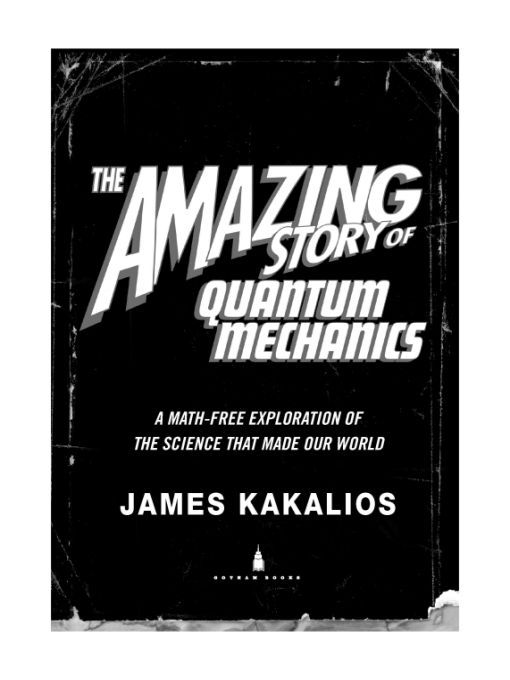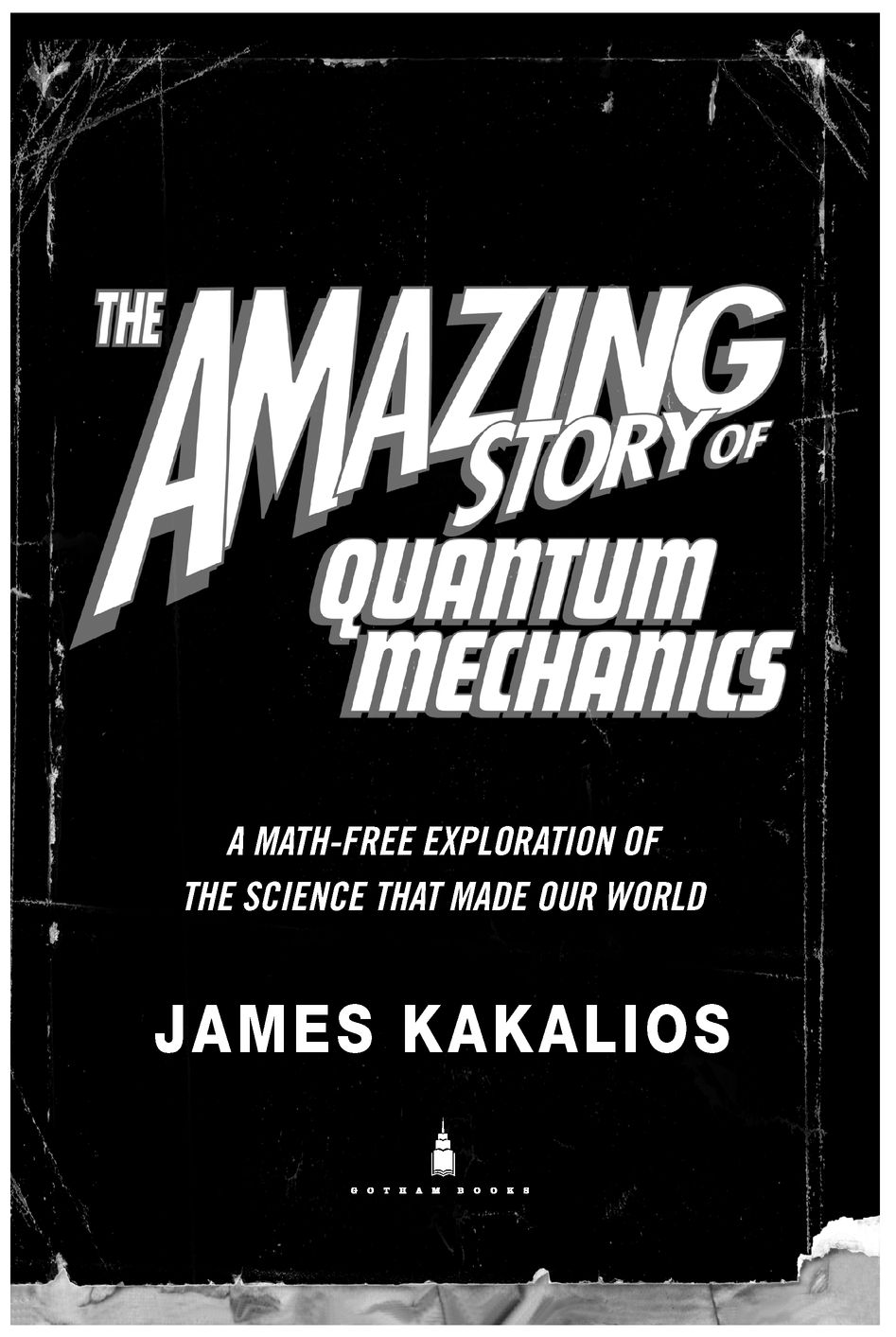Table of Contents
To Thomas, Laura, and David,
who truly make the future
Our citizens and our future citizens cannot share
properly in shaping the future unless we understand the
present, for the raw material of events to come is the
knowledge of the present and what we make it.
LIEUTENANT GENERAL LESLIE R. GROVES
(WHO OVERSAW CONSTRUCTION OF THE PENTAGON AND WAS
CHIEF MILITARY LEADER OF THE MANHATTAN PROJECT)
FROM THE FOREWORD TO Learn How Dagwood Splits the Atom
WRITTEN BY JOHN DUNNING AND LOUIS HEIL AND DRAWN BY JOE MUSIAL
(KING FEATURES SYNDICATE, 1949)
INTRODUCTION
Quantum Physics? Youre Soaking in It!
Perhaps you share my frustration that, well into the twenty-first century, we still await flying cars, jet packs, domed underwater cities, and robot personal assistants. From the 1930s on, science fiction pulp magazines and comic books promised us that by the year 2000 we would be living in a gleaming utopia where the everyday drudgery of menial tasks and the tyranny of gravity would be overcome. Comparing these predictions from more than fifty years ago to the reality of today, one might conclude that, well, weve been lied to.
And yet... and yet. In 2010 we are able to communicate with those on the other side of the globe, instantly and wirelessly. We have more computing power in our laptops than in the room-size computers that were envisioned in the science fiction pulps. We can peer inside a person, without the slice of a knife, performing medical diagnoses using magnetic resonance imaging. Touch-activated computer screens, from the local ATM to the iPhone, are everywhere. And the number of automated devices we deal with in a given day is surprisingly highthough none of them look like Robby the Robot.
What did the all those rosy predictions miss? Simply put, they expected a revolution in energy, but what we got was a revolution in information. Implicit in the promise of jet packs and death rays is the availability of lightweight power supplies capable of storing large amounts of energy. But the ability of batteries to act as reservoirs of electrical energy is limited by the chemical and electrical properties of atoms. Scientists and engineers are extremely clever in developing novel energy-storage systems, but ultimately we cant change the nature of the atoms. Information, however, requires only a medium to preserve ideas and intelligence to interpret them.
Moreover, information can endure for thousands of yearsconsider the long-term data storage accomplished by the Sumerians, whose cuneiform writing on clay tablets enables us to learn about their accounting systems and read the epic tale of Gilgamesh from four thousand years ago. These dried clay tablets, currently held in modern-day Iraq, are fairly bulky, and to share information from them the ancient Sumerians had to transport the actual tablets. But today you dont have to go to Iraq to read the Sumerian tabletsyou can view them on the Internet, or someone could send images of them to you instantly via a cell phone camera.
These advances in content storage and transmission were made possible by the development of semiconductor devices, such as the transistor and the diode. Back when the science fiction pulp magazines were first published, data manipulation proceeded via bulky vacuum tubes; the first computers employed thousands of such tubes, along with relay switches consisting of glass tubes filled with liquid mercury. The replacement of these tubes and mercury switches with semiconductor devices enabled an exponential increase in computing power accompanied by a similar decrease in the size of the computer. In 1965 Gordon Moore noted that approximately every two years the number of transistors that could be incorporated onto an integrated circuit doubled. This trend has held up for the past forty years and underlies the technological innovations that define our modern life: from book-size radios in the 1950s to an MP3 player no larger than a stick of gum in 2005; from a cell phone the size of a brick in the 1970s to one smaller than a deck of cards today. These advances in miniaturization have come with continued improvements in the ability to preserve and manipulate information. (If energy storage also obeyed Moores law, experiencing a doubling in capacity every two years, then a battery that could hold its charge for only a single hour in 1970 would, in 2010, last for more than a century.)
With no transistors, computers would still require bulky vacuum tubes, each one generating a significant amount of heat as it regulated electrical currents. A modest laptop computer currently employs approximately more than a hundred million solid-state transistors for data storage and processing. If all of these transistors were replaced with vacuum tubes, each one a few inches long and at least an inch wide, their physical dimensions, and the need to space them apart to avoid overheating, would yield a vacuum tube computer larger than the White House. Obviously, few institutions aside from the federal government and the largest corporations could afford such a massive computing device. We would consequently live in a relatively computer-free world. With computers rare, there would be no need to link them together, and no need to develop the World Wide Web. Commerce, journalism, entertainment, and politics would exist under the same constraints they did in the 1930s. If wed had a revolution in energy storage (like the pulps predicted) rather than information storage, we could zip to work with jet packs, but once we got there wed find no cell phones, no DVD or personal video recorders, no laser printers, and no personal computers.
The field of solid-state physics, which enabled the development of these and other practical devices, is in turn made possible through quantum mechanics. While science fiction writers were imagining what the future would look like, scientists at industrial laboratories and research universities were busy using the new understanding of the quantum world to create the transistor and the laser. These basic devices form the foundation of our modern lifestyle and have transformed not just consumer electronics, but chemistry, biology, and medicine as well. All of our lives would be profoundly different if not for the efforts in the first quarter of the twentieth century of a handful of physicists trying to understand how atoms interact with light. These pioneers of quantum mechanics recognized that they were changing the face of physics, but they almost certainly did not anticipate that they would also change the future.

In this book I will explain the key concepts underlying quantum mechanics and show how these ideas account for the properties of metals, insulators, and semiconductors, the study of which forms the field of solid-state physics. Ill describe how the magnetic properties of atomic nuclei and atoms, an intrinsically quantum mechanical phenomena, allow us to see inside the human body using magnetic resonance imaging and store vast libraries of information on computer hard drives. The wonders enabled by quantum mechanics are almost too many to name: devices such as lasers, light-emitting diodes, and key-chain memory sticks; strange phenomena including superconductivity and Bose-Einstein condensation; and even brighter brights and whiter whites! And well see how the same quantum phenomena that changed the very nature of technology in the last fifty years will similarly influence the growing field of nanotechnology in the next fifty years.












